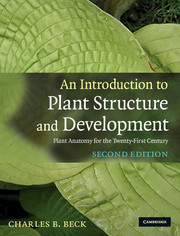Book contents
- Frontmatter
- Contents
- Preface to the second edition
- Preface
- Acknowledgements
- General references
- Chapter 1 Problems of adaptation to a terrestrial environment
- Chapter 2 An overview of plant structure and development
- Chapter 3 The protoplast of the eukaryotic cell
- Chapter 4 Structure and development of the cell wall
- Chapter 5 Meristems of the shoot and their role in plant growth and development
- Chapter 6 Morphology and development of the primary vascular system of the stem
- Chapter 7 Sympodial systems and patterns of nodal anatomy
- Chapter 8 The epidermis
- Chapter 9 The origin of secondary tissue systems and the effect of their formation on the primary body in seed plants
- Chapter 10 The vascular cambium: structure and function
- Chapter 11 Secondary xylem
- Chapter 12 The phloem
- Chapter 13 Periderm, rhytidome, and the nature of bark
- Chapter 14 Unusual features of structure and development in stems and roots
- Chapter 15 Secretion in plants
- Chapter 16 The root
- Chapter 17 The leaf
- Chapter 18 Reproduction and the origin of the sporophyte
- Glossary
- Index
- References
Chapter 17 - The leaf
Published online by Cambridge University Press: 05 June 2012
- Frontmatter
- Contents
- Preface to the second edition
- Preface
- Acknowledgements
- General references
- Chapter 1 Problems of adaptation to a terrestrial environment
- Chapter 2 An overview of plant structure and development
- Chapter 3 The protoplast of the eukaryotic cell
- Chapter 4 Structure and development of the cell wall
- Chapter 5 Meristems of the shoot and their role in plant growth and development
- Chapter 6 Morphology and development of the primary vascular system of the stem
- Chapter 7 Sympodial systems and patterns of nodal anatomy
- Chapter 8 The epidermis
- Chapter 9 The origin of secondary tissue systems and the effect of their formation on the primary body in seed plants
- Chapter 10 The vascular cambium: structure and function
- Chapter 11 Secondary xylem
- Chapter 12 The phloem
- Chapter 13 Periderm, rhytidome, and the nature of bark
- Chapter 14 Unusual features of structure and development in stems and roots
- Chapter 15 Secretion in plants
- Chapter 16 The root
- Chapter 17 The leaf
- Chapter 18 Reproduction and the origin of the sporophyte
- Glossary
- Index
- References
Summary
Perspective: evolution of the leaf
All vascular plants except their most primitive ancestors are characterized by leaves (see Chapter 1). As the primary photosynthetic organs, leaves are of great significance not only to the plant but also to many other organisms, including humans, that rely on plants as a source of food. Botanists interested in plant evolution believe that leaves evolved in at least two ways, and in possibly five independent lines in vascular plants (see Niklas, 1997). The leaves of lycophytes are considered enations because they are thought to have evolved as simple outgrowths from stems. These leaves, often referred to as microphylls, are commonly small although those of some extinct taxa attained great lengths (up to 1 meter in some members of the Lepidodendrales). Like all microphylls, however, they were vascularized by only a single midvein. In seed plants and ferns (possibly also in sphenophytes) leaves are thought to represent evolutionarily modified lateral branch systems. This hypothesis (the telome hypothesis) is based on the fact that the earliest seed plant ancestors were leafless, but bore small lateral branch systems. The fossil evidence indicates that over time, three-dimensional branch systems became flattened and subsequently laminate. Seed plant leaves which, on average, are much larger, and much more complex than those of lycophytes in both gross morphology and internal structure, are often referred to as megaphylls. For more detailed discussions of the evolution of leaves see Steward and Rothwell (1993) and Taylor and Taylor (1993).
- Type
- Chapter
- Information
- An Introduction to Plant Structure and DevelopmentPlant Anatomy for the Twenty-First Century, pp. 324 - 360Publisher: Cambridge University PressPrint publication year: 2010
References
- 1
- Cited by

